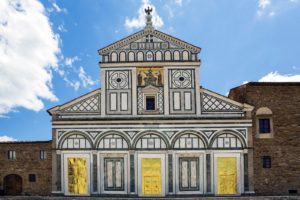 On 27 June 2018, the Italian artist Giovanni de Gara had done his first installation of his series “Eldorato” at the Florentine church of San Miniato Al Monte. He covered the church portals with golden thermal blankets. The installation itself is very poetically. Nevertheless, it was discussed controversially. In an interview, Giovanni explains the background and development of the project.
On 27 June 2018, the Italian artist Giovanni de Gara had done his first installation of his series “Eldorato” at the Florentine church of San Miniato Al Monte. He covered the church portals with golden thermal blankets. The installation itself is very poetically. Nevertheless, it was discussed controversially. In an interview, Giovanni explains the background and development of the project.
Astrid Gallinat: The golden thermal blankets have become a symbol for immigrants in Italy. Other artists have worked with them to point to the refugee tragedy like Bruna Esposito. But your work “Eldorato” is an installation in public space and in addition often at church doors. What is the idea behind?
Giovanni de Gara: Eldorato is a project, which recount the illusion of this millennium: the existence of a golden land, where is well-being and future. It is a land, from which we know little, but we are imagining marvels; a land hidden beyond the horizon.
The objective of the project is, to encourage a deep reflexion about the theme of welcome towards every individual person, without distinction of race, gender, faith, to give a sign of warmth and salvation, starting by the contemplation of the shining gold, not for the carats, but for the beauty and simplicity of the message.
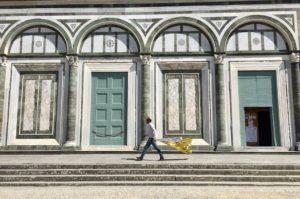 A.G.: Why do you have chosen churches for you installation in public space?
A.G.: Why do you have chosen churches for you installation in public space?
G.d.G.: I think that at the churches, the signification is deeper, because the church has had always a relation with gold. In former times, it was used to represent God. Besides, there is always the controversial question about the richness accumulated during the years, which is against the invitation to poverty and sharing with your neighbour that Jesus instructed.
A.G.: Why have you chosen the name “Eldorato”?
G.d.G.: The title of the project “Eldorato” is an evident distortion. On one hand, there is the imaginary land par excellence, the famous never found land: the Eldorado. On the other hand, we are living in a time of counterfeits, imitations and fake news. It seemed to me to be an adapted representation of our time. Additionally, “El” means in the Hebrew root God. On the doors of the churches, it becomes “Dio-dorato” (Golden God).
A.G.: You are cooperating with several people who are not artists. Who are they and which is their role in the project?
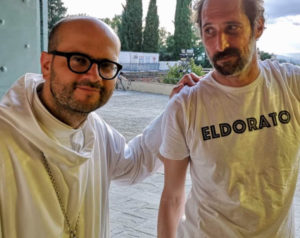 G.d.G.: The journey of Eldorato will be recounted in a documentary-film by the filmmaker Pietro Pasquetti, who follows every installation. He will collect stories and reflexions connected with the project during its itinerary. The photo-reporter Francesco Malavolta (follows since twenty years the people in movement at the gates of Europe) will accompany the project with a series of snapshots chosen specifically for Eldorato. In addition, there are Padre Bernardo Gianni (Abbot of San Miniato al Monte), Tomaso Montanari (art historian), Stefano Mancuso (scientist, founder of the vegetal neurobiology), Don Andrea Bigalli e Don Paolo Tofani (Association Libera), who were the first adherents. Partially, I knew them before. They welcomed the project with a lot of enthusiasm and offered to help me during the realisation. This could be by their interventions or their contacts. The idea is to create a network between the people, who want to engage to oppose this government and their decisions with the competences of their work. Eldorato is a condition, a state of mind to group all, the more divers, the better it is!
G.d.G.: The journey of Eldorato will be recounted in a documentary-film by the filmmaker Pietro Pasquetti, who follows every installation. He will collect stories and reflexions connected with the project during its itinerary. The photo-reporter Francesco Malavolta (follows since twenty years the people in movement at the gates of Europe) will accompany the project with a series of snapshots chosen specifically for Eldorato. In addition, there are Padre Bernardo Gianni (Abbot of San Miniato al Monte), Tomaso Montanari (art historian), Stefano Mancuso (scientist, founder of the vegetal neurobiology), Don Andrea Bigalli e Don Paolo Tofani (Association Libera), who were the first adherents. Partially, I knew them before. They welcomed the project with a lot of enthusiasm and offered to help me during the realisation. This could be by their interventions or their contacts. The idea is to create a network between the people, who want to engage to oppose this government and their decisions with the competences of their work. Eldorato is a condition, a state of mind to group all, the more divers, the better it is!
A.G.: Your project is open political. What are your intentions and hopes?
G.d.G.: The hope is to see a church, which is poor and welcoming and which is shining for humanity and openness and not by the carats. There is a need to take a position and detach from the political decisions taken in the name of the gospels, (the interior minister Salvini is showing the gospel to defend the Christian value and the national ones). It is not acceptable, that Christians don’t take distance from this attitude. Italy declares itself as a Christian faithful country. Nevertheless, these decisions are the exact opposite of what is written in the gospels. Therefore, I feel the necessity to denounce this hypocrisy and to show at the same time what really incarnate the Christian message. Eldorato is also a documentation about the current situation in Italy. Hence, I am as well interested about the NO’s that I receive.
 A.G.: How long have you planned the project?
A.G.: How long have you planned the project?
G.d.G.: I proposed the project in March 2018 to the abbot of San Miniato Al Monte. Then, with the closing of the ports, the abbot called me and asked to do the installation as soon as possible. So on the 27 June was the inauguration.
A.G.: Do you think “Eldorato” is getting more attention because of the actual Italian government and especially because of the events around the Aquarius und the Diciotti?
G.d.G.: As I said before, the project started at the moment, when Salvini closed the harbours. Hence, every action in this direction reinforces the sense of Eldorato and legitimate the repetition. So the project has taken a strong political valence, even if the original departure was a reflection about the gold of the church in the history of art declined in our time. It was a mystic-alchemical reflection, which was also about the actuality and denounce, regarding not only migrants, but concerning all people or who are discriminated.
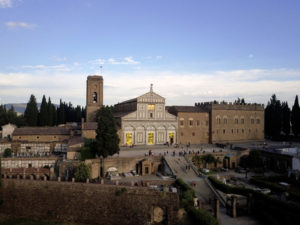 A.G.: Your first intervention was at the church of San Miniato al Monte in Florence. Why have you chosen this place?
A.G.: Your first intervention was at the church of San Miniato al Monte in Florence. Why have you chosen this place?
G.d.G.: The symbolic place from where the Eldorato is departed is the Abbey of San Miniato al Monte, which is dedicated to Miniato, an Armenian refugee. Built exactly 1000 years ago, it is celebrating its 1000 years with a series of events. Moreover it is built on a hill which dominates Florence and was imagined as “gate to heaven” and anticipation of the splendour of paradise. Its cemetery has the name “graveyard of the holy gates”.
A.G.: Was it complicated to get the permission?
G.d.G.: It was not complicated, since I know the abbot well. He has excellent relations to the superintendent; hence, I had the O.K. in a few days’ time.
A.G.: How was the reaction of the clerics to your project?
G.d.G.: The monks were all very partaken and very pleased about it.
A.G.: I read that you would like to make also an installation at St. Peters in Rome; do you already have any reactions to this?
G.d.G.: I have not yet contacts with the Vatican or feedback, but when I have the documentary-film of the 15 churches where I do the installation, I will send all the material to the Pope in the hope to finalise the itinerary at the threshold of St. Peters as global message of hospitality.
A.G.: A part of the project is to discuss immigration with local communities. What are the reactions?
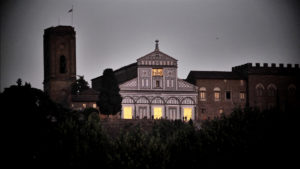 G.d.G.: The reactions in the social media and the press are from all directions in the sense that the installation had pleased a lot or attracted disgust, based on the party or opinion which someone has about migrants and not about the artistic action. There were many discussions, but in typical Italian way: superficial and not objective. I guess, when I’m doing the churches in the north of Italy, the discussion will be newly animated.
G.d.G.: The reactions in the social media and the press are from all directions in the sense that the installation had pleased a lot or attracted disgust, based on the party or opinion which someone has about migrants and not about the artistic action. There were many discussions, but in typical Italian way: superficial and not objective. I guess, when I’m doing the churches in the north of Italy, the discussion will be newly animated.
A.G.: How are you financing the project?
G.d.G.: At the moment, I’m paying everything myself, but I’m searching for private sponsors, who help me to finance the trips and the documentary-film. I prefer to ask third parties to finance the project , instead of asking the church, which already is doing a lot, and is dedicating herself for others. I thought as well to sell some works for the financing.
A.G.: You will do installations in several other Italian cities. How do you decide where you go?
G.d.G.: I have chosen cities, which seem to me the most significant, either because of what they are doing to accommodate or for the visibility that the message could have. In some cases, it was they who proposed to bring the project in their city or their church.
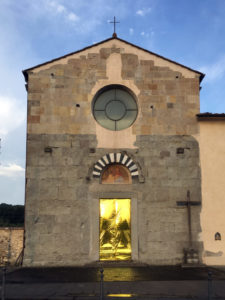 A.G.: Which will be the next ones and when?
A.G.: Which will be the next ones and when?
G.d.G.:
Lampedusa: 3 October
Palermo: 10 October
Bologna (Methodist-Valdese church): 13 October
Parma (San Giovanni): 20 October
Padua (Cathedral): 2 November
Marghera (Venice): 8 November
Lucca (Cathedral): November
Val di Ledro (Trento): 25 December
For the following cities, the dates have to be confirmed: Riace, Genova, Assisi, Perugia, Torino (Valdese Church), Palermo (Valdese Church and commune), Agrigento and ROME.
A.G.: Is the project limited to Italy only?
G.d.G.: In the moment, it is only Italy, but I would like to go with the project as well to Spain and France. If someone is interested to have the project in his/her own city, he/she can write me a mail: giovannidegara@hotmail.it.
A.G.: Thank you very much for the interview. I wish you very much success for the realisations!
Giovanni de Gara
Born in Florence, Italy in 1977 Giovanni is graduated in architecture. Since 2005, he is dedicated to contemporary art.
Giovanni initiated several national and international projects, often outside the context of galleries and in the sense of artistic self-organisation. Exemplary is the foundation of the FAF, Florence Art Factory in 2008, a space for cultural production in performance and electronic music. Moreover, in 2015, he established with other Florentine artists BenzoPlanet for the commercialisation of conceptual products, like his multiple “L’ago nel pagliaio” (Needle in a haystack). Besides, he promotes his own creations like in 2016, when he asked collectors to adopt him as artist to receive in return regularly artworks from him.
As multidiscipline artist, Giovanni creates paintings, objects, installation and performances. Currently, he works on his project “Eldorato”, with a series of installations at church portals. Until the 3rd November 2018, he participates with the artist due Antonello Ghezzi in the exhibition “Esodo” at the Bolognese gallery Spazio Testoni. Here are some of his artistic reflections about Eldorato.
